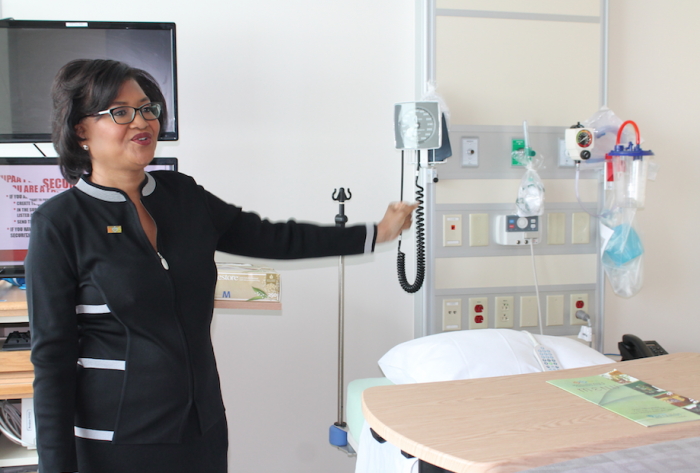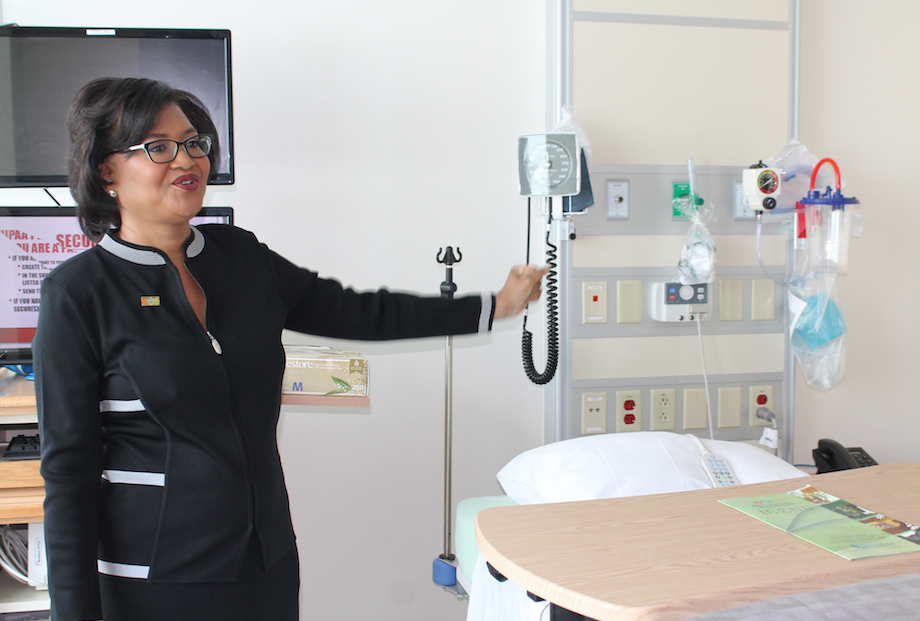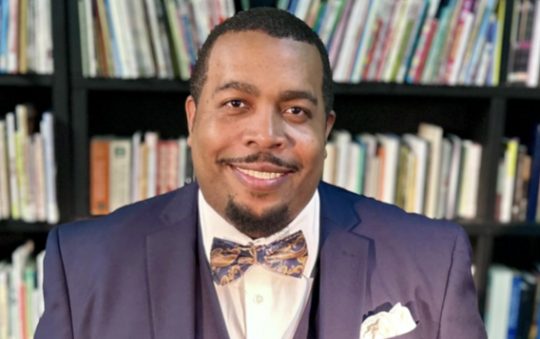
In July 2015, the new Martin Luther King Jr., Community Hospital opened its doors to much fanfare and to the delight of community members who unanimously agreed that it was well worth the wait. The Los Angeles Sentinel set down with the Chief Executive Officer of MLK, Elaine Batchlor, MD, MPH, to discuss quality care at the new MLK hospital.
LAS: Congratulations on your selection to this position. You must be
thrilled.
EB: Thank you. I’ve really enjoyed the journey that I’m on. It’s been a
interesting undertaking. It’s really something that touches me deeply.
LAS: I know that a goal of yours is to improve access to care for underserved areas. If you had to give the hospital a grade today in terms of that goal, what would that grade be?
EB: I don’t know what the grade would be but I can tell you that I am really
thrilled that we opened the hospital on time, and that we are able to
bring a state of the art, high quality hospital to a community that has an
urgent need for it. I’ve been working on this project since 2010 and it feels
good to bring quality health care to this community.
LAS: Was it difficult to step into this position knowing that it was going to be an uphill battle?
EB: It wasn’t. It was an opportunity to build the hospital from the ground up based on patient safety, and family centered care. That motivated us and still guides us everyday.
LAS: It had to be a daunting task to think about the needs of the community and how to overcome their apprehensions about the hospital…did you have sleepless night thinking about it.
EB: Los Angeles is a community of 1.35 million people who have had long-standing and chronic health disparities. You’ve got higher rates of health problems in this community and they are related to the fact that there is also a severe shortage of providers.
We are missing 1700 physicians in this community and that combination of being medically underserved and having longstanding chronic health conditions; that’s what keeps me up at night, is figuring out how to overcome those challenges.
Because of MLK, we are able to bring new providers into the community, and to use technology to overcome some of those deficits of providers. We are also able to go out in the community and teach people how to manage chronic diseases.
LAS: There has been a great deal of discussion about how technologically savvy the hospital is now. Are there any particular areas that you are most proud of?
EB: We are proud of the fact that we have opened the hospital with state of the art technology. We have all new equipment in the hospital. We have a brand new electronic health records system. We are paperless and all digital. And what I really love is that our medical equipment integrates with the electronic health records system.
Just to give you an example, we have beds that we call smart beds. These beds weigh patient’s everyday and that information goes directly into their electronic medical record. If a patient has an IV, as the bag runs down, a signal is sent to the pharmacy and the pharmacy knows to send the next bag of medicine. These are a few examples of how we are using technology to better serve our patients.
Another feature of our smart beds is that in hospitals, falls are a big challenge. Our smart beds are programmed so that if a patient who’s at risk for falls, tries to get out of bed by lowering the rails, a message is sent to their nurse, who is carrying a care phone and she knows that she needs to come and attend to that patient.
We have programmed quality, and safety into the care that we are delivering through these devices, the electronic medical records system and through our care protocols
LAS: I read that when a patient is checked into the hospital, they are given the names of their nurses and doctors.
EB: The patient and their family are an important part of the care team.
On a board in their room are the names of their care team members. We have a patient interactive system that looks like a TV screen but its more than that. It’s a training and educational tool. We can monitor pain, patient’s can see the menu in the cafeteria, and they can watch television and movies.
LAS: How are patients able to provide feedback once they leave your care?
EB: That’s a wonderful question. They actually start giving us feedback while they are here in the hospital through the patient interactive system. After a patient leaves, they receive a survey asking about their stay; we review those surveys and look at the experiences that our patients are having and identify opportunities to improve our services.
LAS: In all of your experiences in the health care industry, what has helped prepare you most for your role as CEO of MLK?
EB: I’ve spent most of my career doing administration and working to expand access for underserved communities. Right before I took this job, I was the chief medical officer for LA Care Health Plan.
In that job, I got to know the communities in Los Angeles, including South LA. I got to know the providers and some of the challenges that people were facing in terms of having access to quality care.
LAS: Did you always know that you wanted a career in medicine?
EB: I date my interest in medicine back to when I was a teenager. I read a book that had a big influence on me called “Dear and Glorious Physician.” It was about St. Luke who was a physician. And the way this story portrayed St. Luke was that as a physician he was involved in science, healing, public advocacy, and addressing health conditions in communities. And practicing that type of medicine appealed to me.
LAS: You have become the main face of the new MLK hospital. How has the community responded to you?
EB: The community has been very excited and thrilled to have a beautiful, state of the art hospital opening up to serve them. Before the hospital opened, we began our community outreach to get to know the people and for them to get to know us. We invited members of the community to come in and tour the facility to see what its like. We are still conducting those tours and we are still out in the community advancing our wellness programs.
LAS: This is a beautiful facility. I imagine that the morale of the staff is high. Have you given thought to how you will sustain the good will that you have?
EB: We have a marvelous staff and one of the things that I like to tell the staff is about the number of people who applied for jobs at the hospital so that they understand that they were selected from a very large pool. We do regular orientations for our new staff; we talk about our mission, our vision, values, and community programs.
The morale of the staff is terrific. People come to work here for two reasons:
One is the mission of the hospital and serving the community and the second reason is the opportunity to build a new organization from the ground up and to make it the best organization possible.
LAS: With Obama Care, how will the hospital balance the surge in the number of persons who now have access to care and the costs of running the hospital.
EB: We are focused on providing access and making sure that the community is taking advantage of coverage programs that are new with Obama care. We conduct healthcare fairs; we go into beauty salons, barbershops, farmers markets, and grocery stores to let people know about the programs that they are newly eligible for.
We are a safety net hospital, which means that we were designed to serve the entire community regardless of their income, insurance coverage, or immigration status and we have sufficient funding to do that.
LAS: If you had to name three facts that you would want the community to know about the new MLK, what would you say?
EB: The first thing is that we are here to serve them and that we have created the hospital thinking about the needs of our patients and making sure that they are getting the highest quality of care. I would also want people to know that we are brand new and we have a terrific team of people waiting to take care of them.
LAS: Are there community partners who are crucial to the mission of the hospital?
EB: Collaboration is one of our core values. We are a part of a unique public-private partnership. One of the most important partners for us is the County of Los Angeles and the University of California is another key partner. We have key partners in the community; Churches, local schools that we’ve adopted, community organizations like the Boys & Girls Club, and senior centers.
Collaboration is how we got here and it’s a part of how we going to accomplish our mission of improving the health of the community. We are a small community hospital but we have a big vision of a healthy community and we know to achieve that, we will have to work collaboratively with everyone.
LAS: There is still a stigma surrounding mental health care in underserved communities. Are you doing any outreach in the mental health area?
EB: Yes – we have a new psychiatric, urgent care/crisis center called the Exodus Center. It’s open 24 hours a day, seven days a week. Patients can walk in- anytime and get mental health support. Law enforcement can also bring patients there instead of taking them to jail and they can get the help that they need there. We also have an in-patient psychiatric hospital that is a part of County USC.
In December, we will have a homeless, recuperative care program so that when we have homeless patients who are released but still not well enough to go to a shelter, they can go to this recuperative care program and receive supportive care.
LAS: You are an African American, female CEO. Have you given any thought to what that actually means?
EB: Before I took this job, one of my former colleagues said, “You know, if you accept this position, you will be one of the few women leading a hospital?” I do realize that it makes me a role model in a certain sense.
I’m proud to show younger women what they can accomplish and I’m proud to lead this particular hospital.
LAS: Your biggest wish for the hospital?
EB: It’s a pretty simple – that through the work that we do at this hospital that we improve the health of those we ‘re serving. I hope that we provide compassionate, high quality care inside the hospital and that we’re working outside of the hospital, to bring new resources to the community. Because it’s all about the health of the people who live here.







